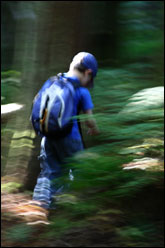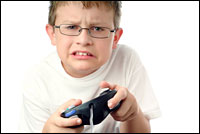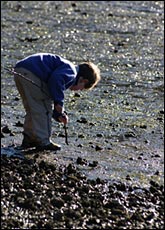Richard Louv is an anecdote machine. As we milled about near the door of a Seattle cafe awaiting lunch-hour seating, he kept up a constant stream of witty, telling stories — about “no running” signs on playgrounds, clueless environmental leaders, suffering outdoor-gear execs. I started fumbling for my recorder.

Richard Louv.
It’s no wonder Louv’s got a trove of such chestnuts: As a longtime journalist (he’s written for just about every leading U.S. newspaper and magazine, and now has a regular column in the San Diego Union-Tribune) and the author of seven books about family, community, and nature, he’s been talking to kids and parents about the maladies and inanities of modern life for years.
His latest book bears the self-explanatory title Last Child in the Woods: Saving Our Children from Nature-Deficit Disorder. After tens of thousands of years of children playing and working primarily outdoors, the last few generations have seen such interaction with nature vanish almost entirely. The implications — for children’s physical and mental health, and for the future of environmentalism — are immense, Louv argues.
But he stresses that there is hope — indeed, that response to the book has him more hopeful than he was when he began writing it. After all, in a world of intractable problems and social malaise, his encouragement to parents is simple and easily achieved: Take your kids outside. (Read part two of this interview in Gristmill.)
What led you to this particular subject?
This is my seventh book, and the second was called Childhood’s Future. I went across the country to interview 3,000 parents and kids about the landscape of family life, which was radically changing. One theme that surprised me was this sense that something profound was changing in the relationship between children and nature.
One little boy said the reason he preferred playing indoors was that’s where all the electrical outlets are. I heard that kind of thing over and over. And the parents were saying, “I don’t understand — how come the kids won’t go outside?” The chapter I wrote about it got picked up by Sierra Magazine and Utne Reader.
Over the years I did some other books, but I kept watching the research on this. The empirical evidence for the split between children and nature is thin because longitudinal studies don’t exist for the most part. Nobody thought to ask the question. We always assumed this relationship [between kids and nature] would be ongoing. Some of the researchers were referring to my chapter as anecdotal evidence, and I thought, if I’m an expert on this we’re really in trouble.
What we do have is circumstantial and anecdotal evidence. We know what kids do: 44 hours a week plugged into electronic media, more time in the car, organized sports, all of that. We know what our own eyes and experience tell us.
What empirical research does exist?
There’s empirical work measuring the radius kids tend to go away from their house. I think between 1970 and 1994 it shrunk to one-ninth of what it had been. There are a few studies like that.

The call of the wild.
But the really interesting research is linking nature to healthy child development. Oddly enough, this topic has not been studied. Now it’s starting to be. A lot of it comes out of the biophilia hypothesis. In all the studies — prisoners in prisons, people in the infirmary — those who have a view of a natural landscape heal faster. Now they’re observing kids playing on natural playgrounds, as opposed to concrete playgrounds. On a natural playground, children think more creatively and are much more likely to invent their own games and play more cooperatively.
There’s research on attention-deficit disorder at the University of Illinois, ongoing studies showing that a little bit of exposure to nature decreases ADD symptoms — even in kids as young as 5. The researchers suggest we add nature therapy to the other two traditional therapies: behavioral modification and Ritalin and other stimulants.
I would also turn it around and ask: Could it be that at least some of the huge increase in ADD has something to do with the fact we took nature away from kids?
While I plead guilty to romanticizing my childhood in the woods, this isn’t an exercise in nostalgia. When you think about it, for tens of thousands of years children spent much of their childhood playing or working in natural settings. Within the space of two or three decades in Western society, particularly in the United States, that’s in danger of ending. This is a radical change in a very short period of time. It’s got to have important, perhaps profound implications for mental health, physical health, and spiritual health — for who we are. We need to take the long view.
What forces have conspired to keep kids inside?

Game over.
Photo: iStockphoto.
Obviously electronics are part of it. Video games and television are fun, and very distracting, and very convenient for parents. I’m not a Luddite. I love my Macintosh — probably too much, as my wife will tell you. I don’t think that video games are the spawn of the devil. I do think it’s a little tough to have a sense of wonder while you’re playing Grand Theft Auto (which, by the way, I played with my sons — they’ve never let me forget that I tried to run over everything in sight).
When I first started interviewing parents, I thought access to nature would be the most important reason kids aren’t going outside. The woods I played in as a kid, in the suburbs on the edge of Kansas City, have been bulldozed. But if you go to the new edge of Kansas City, it looks just like where I grew up. Kids can walk out their back door into the woods if they want. Parents there say the same thing: kids aren’t going outside. So access is important, but it’s not at the top of the list.
The No. 1 reason parents give is: they’re scared. Of “stranger danger.” Child abductions. That fear is changing our lives. The irony is, when you look at the statistics on abductions, almost all are by family members, and the number of abductions has been going down for about a decade. There’s a Duke University study from last year that says kids are safer outside the home than at any time since the 1970s.
If those numbers are going down, what’s going up? I’m afraid it’s people in our profession. I like to think it’s those TV guys, but it’s also print media. You watch CNN or Fox or MSNBC and they take a handful of really terrible crimes against children and repeat them over and over and over again. When they get done telling us about the crime, they tell us about the trial over and over and over again. It’s no accident people think there’s a bogeyman on every corner. We’re literally being conditioned to live in a state of fear, and this predates 9/11.
So parental anxiety is really No. 1 on the list?
Yep. One of the things that’s pleased me is, right after the book came out I started getting emails from parents who have been getting their kids outdoors. One woman wrote and said they’d made a deliberate decision as to where they lived; their kids were spending every weekend in tents out in the woods behind their house, running in to get food and running back out. She wrote, “Now I know why I’m doing what I’m doing and why it’s right.”
A lot of parents have been getting their kids outdoors based on nostalgia or instinct, but didn’t have that body of evidence. We’re an evidence-based society. So that evidence is really affirming to parents who are getting social pressure. What do you mean Johnny isn’t enrolled in Suzuki violin lessons? What do you mean you let your kids build a tree house? Don’t you know they could fall out?
This gets into the issue of comparative risk. Pediatricians will tell you they’re not treating very many broken bones in kids anymore. What they are seeing now are repetitive-stress injuries in children, which generally last a lot longer, sometimes permanently, compared to most broken bones.
I don’t know if it’s a human thing or an American thing, but people’s risk assessment is just awful.
Some of it is parents and institutions: if there’s one thing they’re almost as scared of as strangers, it’s strange lawyers. It’s the litigiousness of the society that’s probably the reason schools put up “no running” signs on the playground.
Early in the book I have a chapter called “The Criminalization of Natural Play.” Add up all the federal, state, and local laws — and all the well-meaning and probably necessary restrictions on kids picking up horny toads and the like. Then add to those the enormous increase in covenants, conditions, and restrictions — about 75 million Americans now live in communities covered by these things, to different degrees. On the first day of the book tour, a woman told me that her community association had just outlawed chalk drawing on sidewalks — which, you know, does lead to cocaine use.
Try to put up a basketball hoop in some of these communities, let alone build a tree house. The message to kids and parents is very clear: nature’s in the past. It doesn’t count anymore. The future’s in electronics. The bogeyman lives in the woods. Playing outdoors is illicit and maybe even illegal.
I’ll never forget the cover story in Parade several years ago: “Dangerous Invaders in Your Neighborhood.” There was a picture of a raccoon on the cover.
Wait, are you defending raccoons, sir?
[Laughs.] I am not now, nor have I ever been, a raccoon.
Most of what you cite are instrumental benefits: better at school, or more well-adjusted. Is that tactical?
That’s what’s been studied.

More rocks than you can poke a stick at.
But there’s a chapter near the end of the book called “The Spiritual Necessity of Nature for Children.” The most important word in the book to me is “wonder.” The root of all spiritual life is that early sense of wonder. When was the first time you had that sense of wonder? It may have been something simple: one of my first memories is watching the dust fall in front of a window. But I also remember going out and turning over rocks, and seeing a universe of bugs that lived underneath — a parallel universe.
There is another world. When a child listens to the leaves in the trees, they sense something bigger than their parents’ problems. That’s more important than keeping grade averages up.
One of the things that’s surprised me: I thought I would get some grief from conservative Christians over nature worship. It’s a deep issue among very conservative Christians.
Paganism.
Yeah. And I took that seriously. Well, as it turns out one of the big proponents of the book is the president of the Southern Baptist Theological Seminary. Whatever one’s spirituality, I think we all understand deep down that a sense of wonder is the beginning of it.
How can urban and suburban areas capture the benefits of getting kids outside?
Not every kid can go to Yosemite or the Cascades. There are kids in my home city of San Diego that haven’t seen the beach. We have to do two things.
First, we have to look at how to increase the amount of nature in urban areas through green urbanism. It’s more popular in Western Europe than here, but interesting, wonderful kinds of eco-cities are being designed. In fact, China’s gonna outpace us on that. We need to bring nature into the city, erase the artificial line between urban and natural. I also have a speculative chapter called “Where the Wild Things Will Be” about the potential resettlement of Great Plains towns that have emptied out with new kinds of eco-towns. I know I’m out on a limb on that — but that’s where the best fruit is.
More simple than waiting for green architecture is what’s called “nearby nature.” Perhaps you have a ravine behind your house, or a little woods at the end of the cul-de-sac. That is hugely important to children. Adults sometimes can’t see the importance of it because they expect nature to be so much bigger, but to that child, that ravine is a universe. Paying attention to that — protecting those little spaces in cities — is a step in the right direction.
In older cities there’s often more nature than we suspect. Can you imagine a city building Central Park today? They’re still finding new species in Central Park. In newer cities, everything is over-manicured, over-controlled. What is a kid supposed to do? I’m just as concerned about kids growing up in those kinds of neighborhoods as I am about inner-city kids.
There does seem to be a huge class-based gap in the amount of nature and unstructured play available.
I went with some gang members up to a nature preserve in the mountains near San Diego. These were really tough guys in their late teens, early 20s. They were with the Urban Corps and had been brought up to cut trails. The first morning in the woods, I realized these guys were terrified. People in these kinds of programs often report that phenomenon. One guy said, “It’s too noisy out here.” I said, “What are you talking about? You’re from a neighborhood where you hear gunfire in the background.” He says, “Yeah, but there’s about four or five sounds in my neighborhood and I know what they all mean. There are a lot of sounds out here and they seem to mean something, but I don’t know what it is.”
Watching these young guys was wonderful — as the day went on, the cynicism left their eyes and the flat affect fell from their faces. By the end of the day, these were 8-year-olds jumping over a creek. The people who work in these programs see that little miracle all the time. No kid in America or anywhere else should go without that miracle.
Read Louv’s thoughts on getting kids excited about environmentalism in part two of this interview, on Gristmill.
Read a review of Richard Louv’s book Last Child in the Woods.


